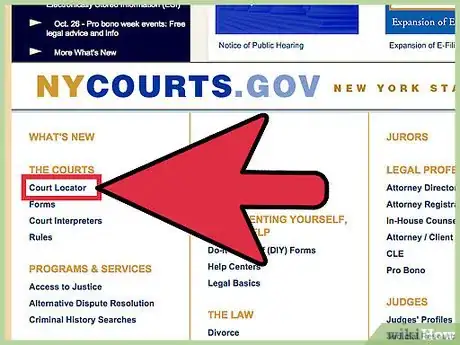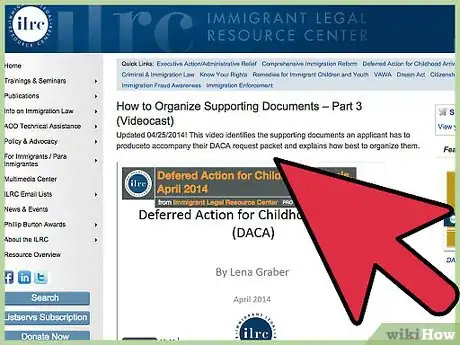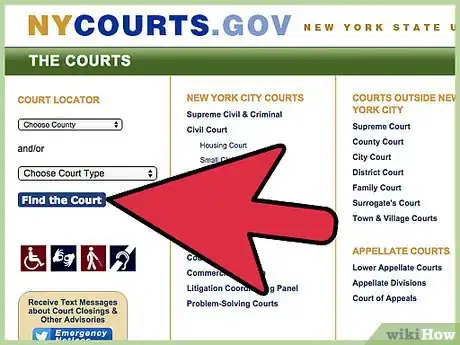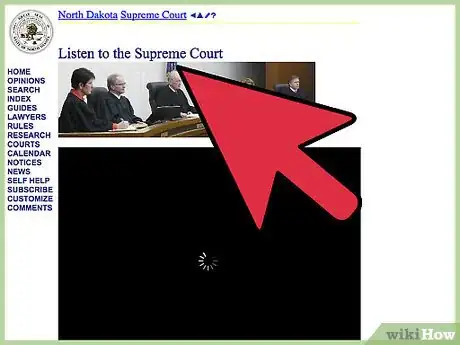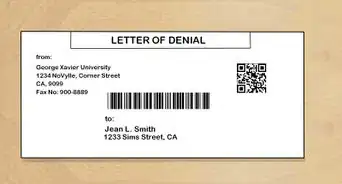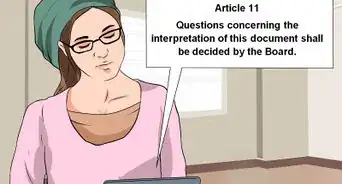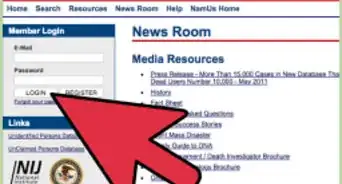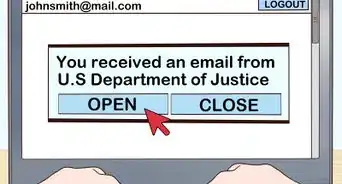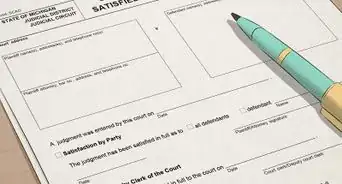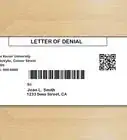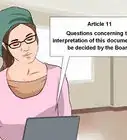This article was co-authored by Clinton M. Sandvick, JD, PhD. Clinton M. Sandvick worked as a civil litigator in California for over 7 years. He received his JD from the University of Wisconsin-Madison in 1998 and his PhD in American History from the University of Oregon in 2013.
There are 10 references cited in this article, which can be found at the bottom of the page.
This article has been viewed 58,513 times.
You sign a contract, take a job, or purchase an item with hopes that it will enhance your life or solve a problem. Discovering the other party lied can be a hard pill to swallow. However, you need to break the transaction into steps. If you can show the other party intentionally lied to you, you may be able to take him to court and prove fraud.
Steps
Understanding Fraud
-
1Define the category of fraud. Even though fraud comes from the English common law, there are several modern categories that most fraud falls into. Understanding the type of fraud can help you prove your case. These types of fraud are also usually criminal in nature and should be reported to law enforcement.
- Telemarketing or mail fraud. The phone call or letter claims that if you "act now" and pay money, you will receive some sort of benefit that seems too good to pass up on. Too late, you discover the truth is that the telemarketing, "Nigerian prince" letters, and other advance fee schemes are fraudulent.[1]
- Health care fraud. This includes doctors or other medical providers over-prescribing or obtaining medical equipment and charging your insurance. Instead of the healthcare you need, you end up with extra co-pays, co-insurance bills, or higher insurance premiums.
- Investment fraud, Ponzi schemes, and pyramid schemes. You are promised a great return if you invest money in the "business." Your profit depends on you recruiting other investors and, unbeknownst to you, any payouts you receive come from money that others have invested.
- Work at Home scams. The backs of magazines are full of them. They promise that by working at home you can stuff envelopes, do assembly work, or start your own computer business. To access this bounty, all you have to do is buy a kit, or invest in equipment, or give your credit card information as a security deposit.[2]
-
2Know the elements of fraud. To prove fraud in court, you must allege and prove all of the elements found in historical common law. In general, you must look for and define six elements:
- There was a statement or representation that was false. The first element of proving fraud is to nail down the statement, also called the representation, that was made to you. The representation can be words or actions presented to you as being the truth.[3] For example, someone offers to sell you an antique painting for $100. This is a fact that, if false, would cause you to change your mind and not complete the deal.[4]
- The other party either knew it was false or acted with reckless disregard to the truth. It's not enough that it be simply misleading, a significant part of the statement must be an outright lie.[5] The false statement must relate to a material fact. For instance, you examined the painting and discovered it was a print or a recently created copy.
- The statement was made intentionally made to induce you to act on it. This can be very difficult to prove. The other party must have known the statement was false. It is not enough for the seller of the painting to be wrong, he must have known he was wrong and intentionally hidden that from you. In this case, the seller wanted you to buy the painting he knew was fake and intentionally lied to get you to do it.
- You relied and acted on the false statement. Reliance means that without the false statement, you would have made a different decision.[6] If you believed what the seller told you and paid $100 for an "antique painting" that proved to be fake, then you relied and acted on the seller's intentionally false statement.
- You suffered damages, either in a direct loss of money or having to spend more money to correct the situation, as a result of acting on the false statement.[7] The purpose of damages is to restore you to where you would be if the fraud had not occurred.
Advertisement -
3Choose a court. If you plan on suing someone for fraud, you will need to select a court to argue your case. If your claim meets the dollar limit, usually $10,000, then you can file your case in small claims court.[8]
- Small claims court has some advantages because the rules of procedure are relaxed and you do not need a lawyer to assist you with the case. However, you still must be able to document and prove each element of fraud in order to win your claim.
- If your losses are more than the small claims limit for your state, you will have to go to the district court. If this is the case, it is strongly recommended that you consult with a civil attorney for an evaluation of your case and potential representation. In civil court, you will be bound by the full rules of civil procedure for your jurisdiction and held to the same standards as the attorneys.
Preparing Your Case for Fraud
-
1Complete the petition. Go to the courthouse in the county where you live. The court clerk will have a form package for small claims court. Fill in every space. Do not leave anything blank. If a question does not pertain to your situation, mark it “N/A.” You will need your name and address and the other party’s name and address.[9]
- In the section where you describe the factual basis for your case, you must reference each and every one of the six elements of fraud as they pertain to your situation. You must identify the false statement that was made intentionally to induce you to act. Then that you acted and suffered damages.
- You must also act for a specific dollar amount in damages. Typically, your damages will be the amount of money you lost in the fraudulent transaction. You can also ask to be reimbursed for your court costs to sue in small claims court.
-
2File the petition with the court. Once you have completed the petition, you must file it with the court clerk in the county where either you or the other party reside. You will have to pay the filing fee, typically $25 to $50. Bring either exact change or a check. Many counties, especially smaller rural court systems, cannot take credit cards.
- The court clerk will give you a court date, usually about 60 days out to leave time for service and to give the other party a fair time to respond and prepare their case.
-
3Have the petition served on the other party. In order for the lawsuit to go forward, you must have the papers legally delivered to the other party. This is called service of process. The easiest way to effect service is to contact the sheriff in the county where the other party is located. Expect to pay around $20 for this action.[10]
- The sheriff will file an affidavit of service with the court when the papers have been delivered.
Gathering Evidence for Your Court Case
-
1Support your fraud claim. When you present your case in court, you will have to prove each of the six elements of fraud. While the rules are relaxed in small claims court, you will have to provide credible evidence for each part of your claim. Using a plaintiff’s checklist can help keep you organized.
-
2Gather the documentation. At this point, you should pull together every scrap of paper that has anything to do with your claim. Good documents include contracts, receipts, cancelled checks, letters, phone messages, and advertising material.
- Make a list of your documents and mark each one with the element of fraud that it supports. For example, an advertisement that is misleading can be the false representation. The invoice where you paid a higher price shows you relied on the advertisement to your detriment. The amount on the sales receipt goes to show your damages.
-
3Establish the testimony. You will not have time for a parade of witnesses in small claims court. Some elements, like intent, may be explained by someone who witnessed your dealings with the defendant. However, you are usually your own best witness. As the plaintiff, you will be able to make a statement, essentially testifying on your own behalf. Look at the six fraud elements and jot down some statements that go to each element. For example, if you questioned the defendant about the price of an item or contract terms, this can go toward the defendant’s intent to defraud you.
-
4Organize your case. Using the statement of facts you wrote in your petition, arrange your documents in order of the elements of fraud. For example, advertisements showed the false price, the defendant’s name on the advertisement shows that he knew what was in the ad and intended the price to be what was listed. The contract shows that you relied on the advertisement. The invoice shows you were charged another price, and your receipt, cancelled checks, or defendant’s collection letter shows your damages.
- Jot down statements about each document. In court, you may be nervous and lose your train of thought. Your notes will keep you on track and help you with a professional presentation.
- Arrange your documents and notes in a binder or folder for easy access during court. Make two copies of each document and collate them into sets. One set is for the judge. The other set is for the defendant. This will make your case go smoother if you don’t have to pass individual documents around.
Appearing in Court
-
1Arrive at court. It is critical that you are on time. If your case is called and you are not present, your case may be dismissed. You should aim on being at least 30 minutes early. This will give you time to find the courtroom and organize your thoughts.
- Give yourself plenty of time to find parking and bring change for the parking meter.
- Arrange childcare ahead of time. Many judges do not allow young children in the courtroom and you cannot leave them in the hallway unattended.
- You don’t have to wear a suit or fancy dress, but your clothing should be neat, clean, professional, and respectful to the court. Don’t wear t-shirts with designs, flip-flops, very short or revealing clothing. Be comfortable. Depending on how many cases the judge has to hear, you could be there for several hours.[11]
-
2Present your case. As the plaintiff, you will speak first. Walk the court through your argument, one element of fraud at a time. Refer to your documents. Finish your presentation with a request for damages and court costs. Plan on keeping your presentation to roughly 15 minutes.
- If the judge asks you any questions, answer them as simply and directly as you can.
-
3Listen to the defendant’s case. After you finish, the defendant will give his side of the story. You have to listen quietly and respectfully. Do not make noises, roll your eyes, or fidget in your chair. Listen attentively and make notes of anything you disagree with.
- When the defendant is finished, the judge may ask if you have any final remarks. If you can rebut anything the defendant said, keep it short, no more than a few minutes.
-
4Receive your decision. The judge will usually make a decision immediately, either in your favor or the defendant. Regardless of how the judge rules, do not comment, complain, or enter into discussion with the defendant. Gather your documents and exit the courtroom.
- The judge may instruct you to go to the clerk’s office for further instructions.
References
- ↑ http://www.nolo.com/legal-encyclopedia/small-claims-court-in-your-state-31016.html
- ↑ http://www.consumer.ftc.gov/articles/0175-work-home-businesses
- ↑ http://legal-dictionary.thefreedictionary.com/fraud
- ↑ http://www.lectlaw.com/def2/m021.htm
- ↑ http://definitions.uslegal.com/f/false-representation/
- ↑ http://www.arizonalawreview.org/pdf/48-4/48arizlrev1001.pdf
- ↑ https://www.law.cornell.edu/wex/fraudulent_misrepresentation
- ↑ http://www.nolo.com/legal-encyclopedia/small-claims-court-in-your-state-31016.html
- ↑ http://www.injuryclaimcoach.com/how-to-file-small-claims.html


